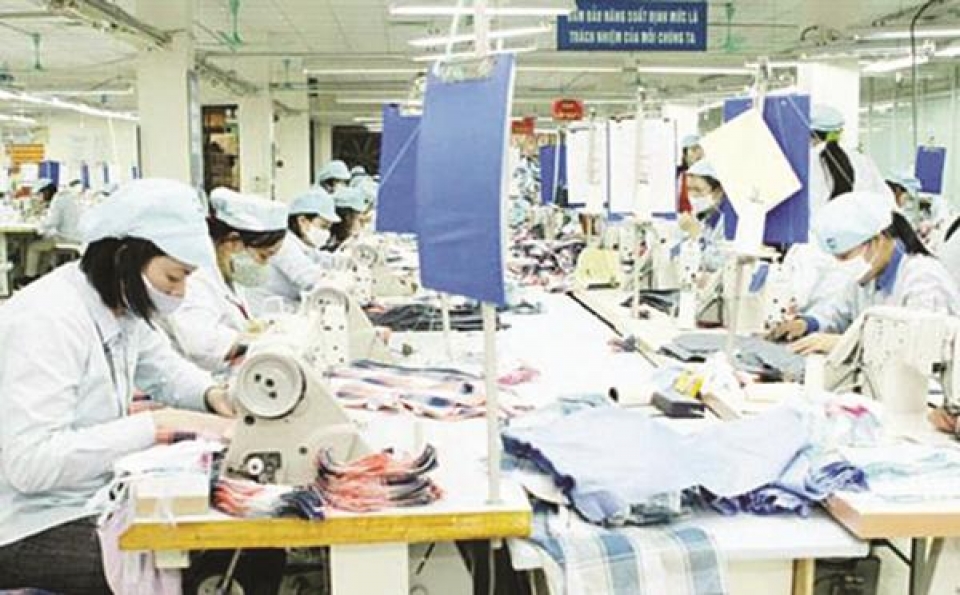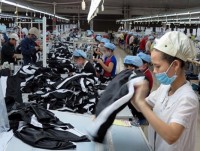Textile Industry plans to overcome hard times
| VN garment sector faces rough 2017 | |
| Garment-textile sector promotes global supply chain | |
| Foreign investment in textile & garment sector falls |
 |
|
Many traders in the textile field are striving to seek orders. Photo: Tran Viet. |
The lowest growth within 10 years In comparison with the previous year, Viet Nam’s textile export is significantly decreasing and traders are coping with a series of difficulties. By the end of October 2016, textile export is estimated to reach $US 23.3 billion, increasing by 4.8% compared to the same period of the year 2015.
This has been the lowest growth figure over the past 10 years. So far, textile exports have not achieved the target of $US 31 billion set at the beginning of 2016. In fact, it is possible for the industry to reach only $US 28 – 29 billion. In reality, the world economy has not recovered, so the consumption demands of the various markets, and trading partners of Viet Nam such as the US, the EU, Japan have not shown their recovery, and consumers tend to strictly control their consumption. Thus, textile exports to the main markets have slightly climbed.
In details, textile exportation to the US has reached nearly $US 10 billion, increasing by 4.37%; to EU: approximately $US 3 billion, increasing by 2.46%; to Japan: around $US2.5 billion, rising by 4.61% and to Korea: over $US 2.2 billion, increasing by 5.34% in comparison with the same period of the previous year.
The market’s demands have reduced, leading to a shortage of orders. Many enterprises are now operating perfunctorily, even accepting losses to maintain their production. Notably, textile enterprises have to witness their clients moving to markets such as Cambodia, India, Bangladesh, and Myanmar. The reason is that these countries promptly have introduced certain policies supporting their domestic enterprises such as devaluating their currencies and supporting enterprises in terms of taxes, which have made Viet Nam’s goods less competitive.
This situation may continue until 2017 as estimated by Mr. Le Tien Truong, General Director of Viet Nam Textile Corporation (VINATEX) because the above-mentioned countries would continue to carry out their enterprise supporting policies as in 2016, particularly policies of devaluing their national currencies to push exports, and attracting more clients and investors. Mr. Truong shared that in 2017, the estimate of the general demand for world textiles would keep on growing slowly.
Especially, the fact that Britain will leave the EU and Mr. Donald Trump, the newly elected US President has announced that the USA will withdraw from the TPP agreement will have negative impacts on Viet Nam’s textile export turn-over to the EU and the US. Invest in production technology In the context of strong competition and lack of orders, some enterprises still stand steadily against difficulties.
Sharing experience in maintaining the position against the hard situation, Mr. Than Duc Viet, Deputy Director General of Garment 10 Joint Stock Company said that it was strong investment in new equipment and automatic assembly that helped Garment 10 increase labour capacity and reduce input costs. He gave an example: in the past an assembly of producing shirts needed two workers to sew button holes and one worker to fix buttons but when installing several supporting devices, one employee could shoulder work of three employees.
Therefore, the labour capacity also increased by three times. Besides, Garment 10 also invested in automatic cutters, ensuring accuracy and quality of the products. In fact, investment in production technology is currently the objective set by Viet Nam textile enterprises. Particularly where the market has signs of balancing demands and supplies; requests of models, fashion and quality of products are rising meanwhile prices of orders are decreasing, investment in technology to raise labour capacity, to get involved in the global supply chain and investment in advance manufacture technology are measures of top priority.
Experts supposed that it was the solution for Viet Nam textile to itself find a path to overcome the hard times which might last until the third quarter of 2017 and to give enterprises a hand to improve their competitiveness in the international market. Discussing this matter, Mr. Park Jun Ho, Director of the Office of the Institute for Korea Industry Technology Research in Viet Nam said that investment in production technology needed a roadmap for implementation.
At present, Viet Nam has not established any specific industry park for textiles. Whereas, the life cycle of fashion is very short, maybe two weeks. In that time, distributors would request new products. Thus, if there is not any specific zone or industry park connecting with manufacturing, Viet Nam may develop centralized zones for textiles to link the phases together, promptly meeting importers’ demands.
 |
Ministry suggests changes in garment industry The Ministry of Industry and Trade has submitted a proposal to Prime Minister Nguyen Xuan Phuc suggesting ... |
In parallel with investment in production technology to improve traders’ competitiveness, traders should consider strategic activity such as trade promotion to seek more markets. “When the markets balance demand and supply, we will lose our competitiveness if we still hire brokers. So, it is necessary to push direct transactions, quickly meeting clients’ demands, especially accelerating delivery for competitiveness” said Mr. Hoang Ve Dung, Deputy Director General of VINATEX.
Related News

Plastic exporters interested in converting to recycling technology
16:36 | 01/11/2024 Import-Export

Vietnam's economy is recovering well
16:42 | 29/10/2024 Headlines

Vietnam - UAE trade grows to billions of dollars
08:55 | 30/10/2024 Import-Export
Latest News

M&A activities show signs of recovery
13:28 | 04/11/2024 Finance

Fiscal policy needs to return to normal state in new period
09:54 | 04/11/2024 Finance

Ensuring national public debt safety in 2024
17:33 | 03/11/2024 Finance

Removing many bottlenecks in regular spending to purchase assets and equipment
07:14 | 03/11/2024 Finance
More News

Continue to handle cross-ownership in banks
10:35 | 02/11/2024 Finance

Striving for average CPI not to exceed 4%
16:41 | 01/11/2024 Finance

Delegating the power to the government to waive, lower, or manage late tax penalties is suitable
16:39 | 01/11/2024 Finance

Removing difficulties in public investment disbursement
09:30 | 31/10/2024 Finance

State-owned commercial banking sector performs optimistic growth, but more capital in need
09:28 | 31/10/2024 Finance

Stipulate implementation of centralized bilateral payments of the State Treasury at banks
09:29 | 29/10/2024 Finance

Rush to finalize draft decree on public asset restructuring
09:28 | 29/10/2024 Finance

Inspection report on gold trading activities being complied: SBV
14:37 | 28/10/2024 Finance

Budget revenue in 2024 is estimated to exceed the estimate by 10.1%
10:45 | 28/10/2024 Finance
Your care

M&A activities show signs of recovery
13:28 | 04/11/2024 Finance

Fiscal policy needs to return to normal state in new period
09:54 | 04/11/2024 Finance

Ensuring national public debt safety in 2024
17:33 | 03/11/2024 Finance

Removing many bottlenecks in regular spending to purchase assets and equipment
07:14 | 03/11/2024 Finance

Continue to handle cross-ownership in banks
10:35 | 02/11/2024 Finance




